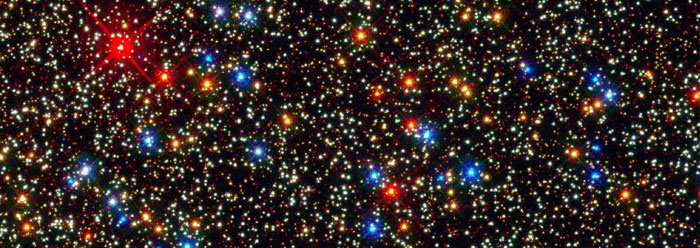Since their discovery, evolutionary astronomers have sought a way to explain how these stars can even exist. They burn fuel so fast that they should have burned out billions of years ago. American astronomers Aaron Geller and Robert Mathieu published in Nature a description of their model for how older stars could have acquired a "new lease on life" by siphoning matter from nearby gas giant stars through "mass transfer."2
They investigated stars within a cluster called NGC 188, found in the constellation Cepheus. It contains 21 blue stragglers, 16 of which are binary stars that closely interact with nearby stars. The researchers suspected that the blue stragglers' partners were white dwarfs, which would be small, leftover remnants of larger red stars that the blue ones had drained of fuel. Such dwarfs are too faint for direct observation, but they have sufficient mass to cause their partner stars to wobble.
Of the 16 binaries, 12 had rotational periods right at 1,000 days and were thus called "long-period" blue stragglers. The study authors ran a statistical analysis that showed "the theoretical and observed [mass] distributions are indistinguishable."2 In other words, their theory that other stars "fed" these 12 blue stragglers matched well with what they observed.
But did this reconcile the relative youthfulness of these binary blue stars with their assumed billions of years of history? The answer is no. The authors wrote, "Blue straggler stars…should already have evolved into giant stars and stellar remnants,"2 and their new observations do not solve this deep-time problem.
Blue stragglers should burn through all their fuel in "a few million years at best."3 But these NGC 188 stars are supposed to be seven billion years old. So, to make them fit that age, these authors maintain that they were not initially blue stars, but instead burned fuel at a normal rate for billions of years. Then suddenly, within the last one million years, all 12 of them began siphoning extra fuel from their binary partners so that they only look young right now.
However, nothing explains the many blue stragglers that are not binary stars and yet exist near and far throughout the universe. Could they have received recent "youthfulness" through collisions with other stars?
In an article summarizing the Geller and Mathieu paper, University of Cambridge astronomer Christopher Tout wrote, "Thus, in this cluster [NGC 188], a collisional origin for blue stragglers is much rarer than expected, and the authors' study casts doubt on whether it occurs at all."4 The modeled scenario in which blue stars form by collision did not match observations.
So, isolated blue stars could not have received their young looks from a binary system, since by definition they have no binary from which to siphon fuel. They probably didn't receive their youthful appearance from collisions, either, according to these results. And though the binary blue stragglers may have siphoned fuel from nearby partners, the idea that 12 of 16 only did so recently—after an imagined 7-billion-year wait—defies reasonable odds.
Thus, the best explanation is still the most straightforward one—blue straggler stars look young because they are young.
References
- Omega Centuri: Colorful Stars Galore Inside Globular Star Cluster Omega Centauri. NASA press release, September 9, 2009.
- Geller, A. M. and R. D. Mathieu. 2011. A mass transfer origin for blue stragglers in NGC 188 as revealed by half-solar-mass companions. Nature. 478 (7369): 356-359
- Thomas, B. Young Blue Stars Found in Milky Way. ICR News. Posted on icr.org June 9, 2011, accessed October 24, 2011.
- Tout, C. 2011. Astrophysics: Stars acquire youth through duplicity. Nature. 478 (7369): 331-332.
Image credit: NASA
* Mr. Thomas is Science Writer at the Institute for Creation Research
